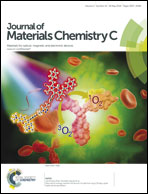Photovoltaic properties of bis(octyloxy)benzo-[c][1,2,5]thiadiazole sensitizers based on an N,N-diphenylthiophen-2-amine donor†
Abstract
Three D–A–π–A sensitizers (DOBT-IV to DOBT-VI) with N,N-diphenylthiophen-2-amine as the donor and bis(octyloxy)benzo-[c][1,2,5]thiadiazole (DOBT) as the auxiliary acceptor have been designed and synthesized. Their applications to dye-sensitized solar cells with I−/I3− and Co(II)/(III) electrolytes were measured and characterized. Via fine tuning of the π-bridge, the highest photoelectric conversion efficiency of 7.16% was obtained with Jsc = 16.88 mA cm−2, Voc = 0.662 V and FF = 64.03% for the DOBT-V based dye-sensitized solar cells using the I−/I3− electrolyte under standard global AM1.5 solar conditions. A photoelectric conversion efficiency of 6.14% was obtained with Jsc = 11.35 mA cm−2, Voc = 0.760 V and FF = 71.16% with the Co(II)/(III) electrolyte under standard global AM1.5 solar conditions. The optical and electrochemical properties and the photovoltaic performance were evaluated and investigated using density functional theory calculations, a behavior study of the four performance parameters with dependence of the incident light intensity, electrochemical impedance spectroscopy and intensity-modulated photo-voltage spectrometry.
![Graphical abstract: Photovoltaic properties of bis(octyloxy)benzo-[c][1,2,5]thiadiazole sensitizers based on an N,N-diphenylthiophen-2-amine donor](/en/Image/Get?imageInfo.ImageType=GA&imageInfo.ImageIdentifier.ManuscriptID=C4TC00169A&imageInfo.ImageIdentifier.Year=2014)

 Please wait while we load your content...
Please wait while we load your content...